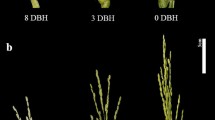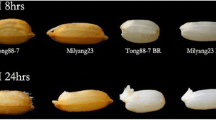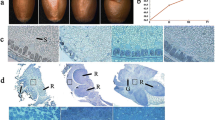Abstract
Rice crops are vulnerable to low temperatures. During development, the reproductive stage is particularly sensitive to cold exposure, which causes abnormal pollen development and a high degree of male sterility. In this study, shotgun proteomic analysis was used to analyze rice anthers containing pollen grains from a cold-tolerant variety, Dianxi 4. Protein expression was compared between normal anthers and anthers exposed to cold temperatures at the young microspore stage. In total, 3835 non-redundant proteins were identified in the rice anther. Of these, 441 proteins were differentially expressed between normal and cold-treated anthers. Pollen allergens, ATP synthase, actin, profilin, and β-expansin proteins were highly abundant, reflecting anther development, pollen germination, and pollen tube elongation. Starch and sucrose metabolic proteins such as α-amylase precursor and 4-α-glucanotransferase exhibited reduced expression after cold exposure. Among the proteins that exhibited increased expression after cold exposure, C2 domain proteins, and GRPs were identified as candidate signaling factors for mediation of the cold tolerance response. Through high-throughput proteomic analysis we were able to reveal proteomic changes against cold stress and suggest two signaling factors as the candidate genes.



Similar content being viewed by others
References
Bocca SN, Magioli CS, Mangeon A, Margis R, Junqueira RM, Jorge VC, Martins GS (2005) Survey of glycine-rich proteins (GRPs) in the Eucalyptus expressed sequence tag database (ForEST). Genet Mol Biol 28:608–624
Castro AJ, Clément C (2007) Sucrose and starch catabolism in the anther of Lilium during its development: a comparative study among the anther wall, locular fluid and microspore/pollen fractions. Planta 225:1573–1582
Chinnusamy V, Zhu J, Zhu JK (2007) Cold stress regulation of gene expression in plants. Trends Plant Sci 12:444–451
Dai S, Chen T, Chong K, Xue Y, Liu S, Wang T (2007) Proteomics identification of differentially expressed proteins associated with pollen germination and tube growth reveals characteristics of germinated oryza sativa pollen. Mol Cell Proteom 6:207–230
Dat J, Vandenabeele S, Vranová E, Van Montagu M, Inzé D, Van Breusegem F (2000) Dual action of the active oxygen species during plant stress responses. Cell Mol Life Sci 57:779–795
Dixon RA, Paiva NL (1995) Stress-induced phenylpropanoid metabolism. Plant Cell 7:1085–1097
Du Z, Zhou X, Ling Y, Zhang Z, Su Z (2010) agriGO: a GO analysis toolkit for the agricultural community. Nucl Acids Res 38:W64–W70
Flores Fusaro A, Sachetto-Martins G (2007) Blooming time for plant glycine-rich proteins. Plant Signal Behav 2:386–387
Fusaro A, Mangeon A, Junqueira RM, Rocha CAB, Coutinho TC, Margis R, Sachetto-Martins G (2001) Classification, expression pattern and comparative analysis of sugarcane expressed sequences tags (ESTs) encoding glycine-rich proteins (GRPs). Genet Mol Biol 24:263–273
Griffin NM, Yu J, Long F, Oh P, Shore S, Li Y, Koziol AJ, Schnitzer JE (2010) Label-free, normalized quantification of complex mass spectrometry data for proteomic analysis. Nat Biotech 28:83–89
Hayase H, Satake T, Nishiyama I, ITO N (1969) Male sterility caused by cooling treatment at the meiotic stage in rice plants: II. The most sensitive stage to cooling and the fertilizing ability of pistils. Jpn J Crop Sci 38:706–711
Imin N, Kerim T, Rolfe BG, Weinman JJ (2004) Effect of early cold stress on the maturation of rice anthers. Proteomics 4:1873–1882
Kerim T, Imin N, Weinman JJ, Rolfe BG (2003) Proteome analysis of male gametophyte development in rice anthers. Proteomics 3:738–751
Khan AA, Downing RD (1968) Cytokinin reversal of abscisic acid inhibition of growth and α-amylase synthesis in barley seed. Physiol Plant 21:1301–1307
Kim CY, Koo YD, ** JB, Moon BC, Kang CH, Kim ST, Park BO, Lee SY, Kim ML, Hwang I, Kang KY, Bahk JD, Lee SY, Cho MJ (2003) Rice C2-domain proteins are induced and translocated to the plasma membrane in response to a fungal elicitor. Biochemistry 42:11625–11633
Kim YO, Kim JS, Kang H (2005) Cold-inducible zinc finger-containing glycine-rich RNA-binding protein contributes to the enhancement of freezing tolerance in Arabidopsis thaliana. Plant J 42:890–900
Kim M, Kim H, Lee W, Lee Y, Kwon SW, Lee J (2015) Quantitative shotgun proteomics analysis of rice anther proteins after exposure to high temperature. Int J Genomics 2015:9
Kovar DR, Drøbak BK, Staiger CJ (2000) Maize profilin isoforms are functionally distinct. Plant Cell 12:583–598
Lapik YR, Kaufman LS (2003) The arabidopsis cupin domain protein AtPirin1 Interacts with the G protein α-subunit GPA1 and regulates seed germination and early seedling development. Plant Cell 15:1578–1590
Lee J, Garrett WM, Cooper B (2007) Shotgun proteomic analysis of Arabidopsis thaliana leaves. J Sep Sci 30:2225–2230
Leyva A, Jarillo JA, Salinas J, Martinez-Zapate JM (1995) Low Temperature induces the accumulation of phenylalanine ammonia-lyase and chalcone synthase mRNAs of Arabidopsis thaliana in a light-dependent manner. Plant Physiol 108:39–46
Long R, Yang Q, Kang J, Zhang T, Wang H, Li M, Zhang Z (2013) Overexpression of a novel salt stress-induced glycine-rich protein gene from alfalfa causes salt and ABA sensitivity in Arabidopsis. Plant Cell Rep 32:1289–1298
Mangeon A, Junqueira RM, Sachetto-Martins G (2010) Functional diversity of the plant glycine-rich proteins superfamily. Plant Signal Behav 5:99–104
McCurdy DW, Kovar DR, Staiger CJ (2001) Actin and actin-binding proteins in higher plants. Protoplasma 215:89–104
Mittler R (2002) Oxidative stress, antioxidants and stress tolerance. Trends Plant Sci 7:405–410
Nalefski EA, Falke JJ (1996) The C2 domain calcium-binding motif: structural and functional diversity. Protein Sci 5:2375–2390
Nishiyama I (1970) Male sterility caused by cooling treatment at the young microspore stage in rice plants: VII. Electron microscopical observations on tapetal cells dilated by the cooling treatment. Jpn J Crop Sci 39:480–486
Nishiyama I (1995) Damage due to extreme temperatures. Sci Rice Plant 2:769–812
Oliver SN, Dennis ES, Dolferus R (2007) ABA regulates apoplastic sugar transport and is a potential signal for cold-induced pollen sterility in rice. Plant Cell Physiol 48:1319–1330
Paoletti AC, Parmely TJ, Tomomori-Sato C, Sato S, Zhu D, Conaway RC, Conaway JW, Florens L, Washburn MP (2006) Quantitative proteomic analysis of distinct mammalian Mediator complexes using normalized spectral abundance factors. Proc Natl Acad Sci 103:18928–18933
Rivero RM, Ruiz JM, Garcıa PC, Lopez-Lefebre LR, Sánchez E, Romero L (2001) Resistance to cold and heat stress: accumulation of phenolic compounds in tomato and watermelon plants. Plant Sci 160:315–321
Sachetto-Martins G, Franco LO, de Oliveira DE (2000) Plant glycine-rich proteins: a family or just proteins with a common motif? Biochimica et Biophysica Acta (BBA). Gene Struct Expr 1492:1–14
Satake T, Hayase H (1970) Male sterility caused by cooling treatment at the young micro-spore stage in rice plants. 5. Estimations of pollen developmental stage and the most sensitive stage to coolness. Nihon Sakumotsugaku Kai Kiji. Proc Crop Sci Soc Jpn 39:468–473
Schutzki RE, Cregg B (2007) Abiotic plant disorders: symptoms, signs and solutions: a diagnostic guide to problem solving. Michigan State University
Songnuan W (2013) Wind-pollination and the roles of pollen allergenic proteins. Asian Pac J Allergy Immunol 31:261
Takaha T, Yanase M, Okada S, Smith SM (1993) Disproportionating enzyme (4-alpha-glucanotransferase; EC 2.4.1.25) of potato. Purification, molecular cloning, and potential role in starch metabolism. J Biol Chem 268:1391–1396
Thimm O, Bläsing O, Gibon Y, Nagel A, Meyer S, Krüger P, Selbig J, Müller LA, Rhee SY, Stitt M (2004) mapman: a user-driven tool to display genomics data sets onto diagrams of metabolic pathways and other biological processes. Plant J 37:914–939
Wang W, Vinocur B, Shoseyov O, Altman A (2004) Role of plant heat-shock proteins and molecular chaperones in the abiotic stress response. Trends Plant Sci 9:244–252
Wilkins MR, Appel RD, Van Eyk JE, Chung M, Görg A, Hecker M, Huber LA, Langen H, Link AJ, Paik YK, Patterson SD, Pennington SR, Rabilloud T, Simpson RJ, Weiss W, Dunn MJ (2006) Guidelines for the next 10 years of proteomics. Proteomics 6:4–8
Yamaguchi T, Nakayama K, Hayashi T, Yazaki J, Kishimoto N, Kikuchi S, Koike S (2004) cDNA microarray analysis of rice anther genes under chilling stress at the microsporogenesis stage revealed two genes with DNA transposon castaway in the 5′-flanking region. Biosci Biotechnol Biochem 68:1315–1323
Yokotani N, Ichikawa T, Kondou Y, Maeda S, Iwabuchi M, Mori M, Hirochika H, Matsui M, Oda K (2009) Overexpression of a rice gene encoding a small C2 domain protein OsSMCP1 increases tolerance to abiotic and biotic stresses in transgenic Arabidopsis. Plant Mol Biol 71:391
Zhu J-K (2016) Abiotic stress signaling and responses in plants. Cell 167:313–324
Zybailov B, Mosley AL, Sardiu ME, Coleman MK, Florens L, Washburn MP (2006) Statistical analysis of membrane proteome expression changes in saccharomyces cerevisiae. J Proteom Res 5:2339–2347
Acknowledgements
This work was supported by the National Institute of Crop Science of the Rural Development Administration, Korea [Grant number PJ01099903].
Author information
Authors and Affiliations
Corresponding author
Electronic supplementary material
Below is the link to the electronic supplementary material.
Rights and permissions
About this article
Cite this article
Lee, J., Lee, Y., Kim, M. et al. Quantitative shotgun proteomic analysis of cold-stressed mature rice anthers. Plant Biotechnol Rep 11, 417–427 (2017). https://doi.org/10.1007/s11816-017-0459-2
Received:
Accepted:
Published:
Issue Date:
DOI: https://doi.org/10.1007/s11816-017-0459-2




